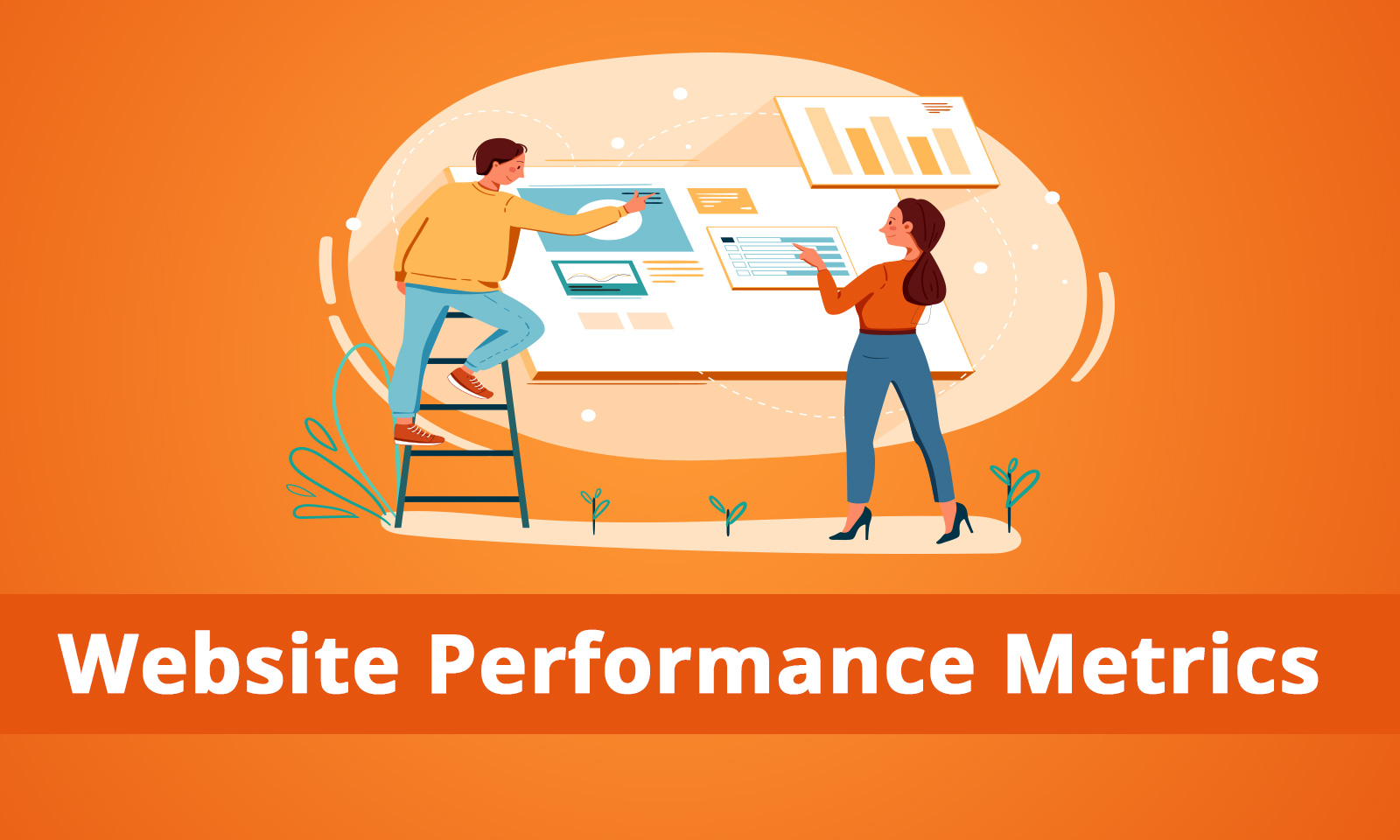Top 10 Website Performance Metrics That Matter In 2022

Introduction
You can’t improve what you don’t measure. Businesses are constantly trying to put the finger on visitor engagement and ROI to optimize their content marketing and online advertising efforts. Without data, you are just shooting in the dark. So here are the top 10 website performance metrics that every business should be paying attention to.
Website performance management usually begins with discussing key performance indicators (KPIs). There are dozens of KPIs to choose from. But the following list, narrowed down to these top ten website performance metrics, should be sufficient for any size of a website on an unmeasured budget.
This blog post will cover the following information:
- User Satisfaction Score (Apdex)
- First Paint (FP) and First Contentful Paint (FCP)
- Time to First Byte (TTFB)
- DNS Lookup Time
- Traffic Source
- Keyword Ranking in SERPs
- CTR & Average Sessions Per Duration
- Bounce Rate
- Theme or Website Design
- HTTP Requests
1. User Satisfaction Score (Apdex)
User satisfaction or Apdex (Application Performance Index) is one of the leading website performance metrics. It measures how long a user has to wait for a website to load completely. It is also the measurement of your users’ level of satisfaction with your site, application, or internet service. The level of user satisfaction will determine whether you will get more customers or lose existing ones.
The Apdex scoring system measures user satisfaction on an interval scale from 0 to 10. The score ranges from 0 to 1, with the value 1 being assigned when users experience time-outs in response times. And 0 when no time-outs occur. A score of 5 indicates that 50% of requests have experienced some delay. A score of 10 indicates that no requests experienced a delay.
The right way to monitor a website’s Apdex score is by using an independent measurement tool–like Google Analytics–that measures your pages every time a user visits them. And tells you what percentage of users are satisfied with them.
For example, you know that a particular page had 200 visitors today. And that 140 of them logged out within a few seconds only.
2. First Paint (FP) and First Contentful Paint (FCP)
The First Paint is the time it takes for the content of a web page to become visible to the user. It’s important to know that this is different from just the time it takes for the page to finish loading.
The First Contentful Paint is when your page has enough content on it that people can start using it, like images and text.
The point of both of these measurements is to know how quickly you need to get content onto the page. So users don’t get frustrated with your site.
When a script is blocking, it means that while a script is downloading, nothing else will load until the script has been downloaded. If you have many scripts on your page, this can delay your First Paint and First Contentful Paint. To optimize your Website Performance Metrics, make sure that you remove any render-blocking scripts from your website’s header sections.
3. Time to First Byte (TTFB)
When a user types in the URL of a website, it takes some time for the web server to process the request. And deliver the HTML document back to the browser.
The length of this time is called Time to First Byte (TTFB). The lower the value, the faster a user will see an image or other file on your website.
TTFB impacts how responsive your site feels to users because they start seeing content on their screen after TTFB. While many factors affect TTFB, ultimately, it is dependent on how quickly your web server processes and delivers the HTML document.
In most cases, TTFB is determined by how fast your server can send content. How fast the client can receive content. And how fast they connect. So it’s essential to test all three.
If you want to decrease the TTFB, you should focus on reducing latency. You can do this by:
Optimizing your code. Make sure bytes are sent as quickly as possible. This will reduce the time between the client request and server response. A fast connection won’t help if the bytes sent over it are slow.
Using a server that is suited for your needs. If you don’t know whether your current hosting plan fits your needs, try to find out. If you need more resources, check if the hosting plan offers good value for money.
Using good CDN. The goal of using a CDN is to transfer less data and serve users faster due to the geographic location of the CDN servers. For example, if you have users from other countries, like Japan or Germany, you should use a CDN with servers in those countries.”
4. DNS Lookup Time
It’s always good to know how the thing you’re using works. For example, if you want to travel around a city without getting lost, it helps to understand how a street address works. What if the person who named streets hadn’t put any numbers on them? That would make things more interesting, but navigation would also be more difficult.
The Domain Name System (DNS) is like a street address, but for the Internet. DNS lets you enter a URL like http://www.google.com instead of having to remember and type in something like 74.125.224.72.
Websites are often slow because of DNS lookup time. When you type in the URL of a site or click on an icon or bookmark, your computer has to find out where that site’s server lives. So that it can connect to it and load the page from there.
DNS Lookup time is among the most important Website Performance Metrics. It is typically measured in milliseconds and denotes the time it takes to resolve a domain name (e.g., www.domainname.com) into its corresponding IP address (e.g., 123.456.789).
This can be done either in-house or externally by a third-party DNS service provider. Such as DynDNS, OpenDNS, or Google Public DNS.
Solving domain name queries is just one of the operations that make up a typical web request. Including TCP handshake, SSL negotiation, HTTP request and response headers, and the actual data transfer itself.
However, since DNS lookups are relatively slow, it is recommended to have them cached on the client-side using recursive servers like Google Public DNS, which can store lookup results for several hours. Or even days for popular domains. Thus, decreasing DNS lookup time considerably and making websites load faster for users.
5. Traffic Source
Traffic source refers to where visitors come from to a particular website. There are primarily two traffic sources: organic and paid. Organic traffic comes from search engines, referrals, and other websites linking to your website. Paid traffic is any visitors that come to your website because of an advertisement (paid or organic).
Organic traffic is free and generally very targeted in nature. Paid traffic is generally not as targeted (unless you specifically target the same audience that your ad is likely to attract). And is more expensive than organic traffic.
So why do we care about traffic sources?
A website’s unique visitors by traffic source will give you a good idea of how well your marketing efforts are working. Are more people coming through search engines, or are they finding you through other means? What percentage of your visitors are “new” versus “returning?” These are all important website performance metrics that can help you determine how much money you should be spending on which ads, keywords, and so on.
In addition, knowing the percentage of organic traffic can even help you determine if your SEO strategy needs some work; if the majority of your overall traffic comes from paid ads with a minimal amount coming from search engine results. Then something needs adjustment.
6. Keyword Ranking in SERPs
One of the most crucial website performance metrics is ranking on search engines for keywords that people are using to find your products and services.
A website can be ranked number one on Google for five keywords. But that website will not generate any leads if nobody searches for those keywords.
Therefore, keyword ranking is important because it can help businesses understand the interests of their target customers.
Businesses that sell products or services can then work to improve those products or services based on their ranked keywords. In addition, keyword ranking gives business owners an idea of what their customers want by seeing what words people are using to find a product or service.
The better keyword ranking improves a website’s performance, and the more relevant its content is to the information people are searching for, the more likely a webmaster is to have his website appear at the top of search engine results pages.
7. CTR & Average Sessions Per Duration
Click-through rate, or CTR, is one of the most critical website performance metrics. CTR measures your ability to convince visitors to click on your page. It is a ratio that compares the number of clicks on the page divided by the total number of impressions (the total number of times your page was displayed).
The average session duration refers to how long users stay on a website before moving on. It is calculated by adding up all the time spent by users while they are on your site and dividing it by the total number of sessions over a specified period. The higher this number, the more time someone spends on average per session.
Google Analytics is a perfect tool for measuring the metrics mentioned above.
For your better understanding:
The key to understanding click-through rate is that it’s an indicator of ad performance, not business results. When you advertise, you are throwing bait into a pond. Some percentage will be nibbled and follow the breadcrumb trail back to your site. That’s the click-through rate!
But just because a fish took the bait does not mean that you will close a sale with them or even sell them another product down the road. Many users may enter through a given ad but not achieve meaningful action on your site (and hence not generate any income).
If you’re paying for traffic, you want to make sure that your money is being spent in ways that will translate into income for you. Not all clicks are created equal. You want users that are more likely to convert into customers based on their online behavior and demographics.
8. Bounce Rate
Bounce rate measures the number of visits that resulted in a page view of any depth followed by a single page view of exit (a visit with only one pageview). The basic idea behind bounce rate is that if a visitor lands on your site and bounces, they are not interested in your content. Some websites will measure this as a percentage.
A low bounce rate is preferable to a high bounce rate because it shows that visitors are engaging with your website. This is an essential indicator of how interested users are in your content, which is one of the most critical factors in search engine rankings.
Why bounce?
In most cases, people don’t just bounce because they’re not interested in what you have to say or sell, but also because something about your site drove them away from the content you have to offer. They may have experienced technical issues or found their way around the site difficult to navigate. You can often use this information to help improve your website’s performance and provide users with a positive experience when visiting your site.
9. Theme or Website Design
Your website theme is one of the factors that can affect your website performance, regardless of how fast your hosting company is. Web design is an integral part of marketing because it’s the first thing people see when they visit your site. Therefore, it should be easily accessible to search engines like Google to help boost your online presence and visibility.
A good website theme should be lightweight, so it shouldn’t slow down page loading time. It should be compatible with any platform and browser so that visitors can view your site’s content without having to download additional files.
And most importantly, it should have less complex codes that load smoothly across all devices.
10. HTTP Requests
HTTP requests measure how many times your web browser has to make a request to the server for something like a picture or script. The larger the number of HTTP requests, the longer it takes for the page to load because more time is spent communicating with the server and waiting for it to send back all the parts of the page.
The best way to make fewer HTTP requests on your website is by combining all of your scripts in one file and then linking them into your HTML using a single <script> tag. This will reduce your HTTP requests and decrease loading time because there will be less data traveling between the browser and server.
The reason this is so important with websites is because each time a page loads in, it makes several HTTP requests to find all of the files that are needed for that one page. The more files you have, and the more places you host them from, the more HTTP requests you’re going to have and thus more waiting around for things to load.
For example, if you were hosting your images on Flickr instead of hosting them yourself, then every image that you wanted on your site would require an additional HTTP request that wouldn’t be required if you hosted them yourself.
Conclusion
And that’s it!
We’ve explored a variety of website performance metrics that you can use to study your own sites, hopefully giving you the information you need to create faster-loading websites.
With the right tools, these metrics will give you much greater insight into your site performance.
Ultimately, by analyzing these metrics, you can make more informed decisions about how to optimize your own site for speed and ultimately boost conversions in the process.
If you want to discuss the possibility of developing a high performing website for your business, contact Mpire Solutions for a FREE Consultation.




